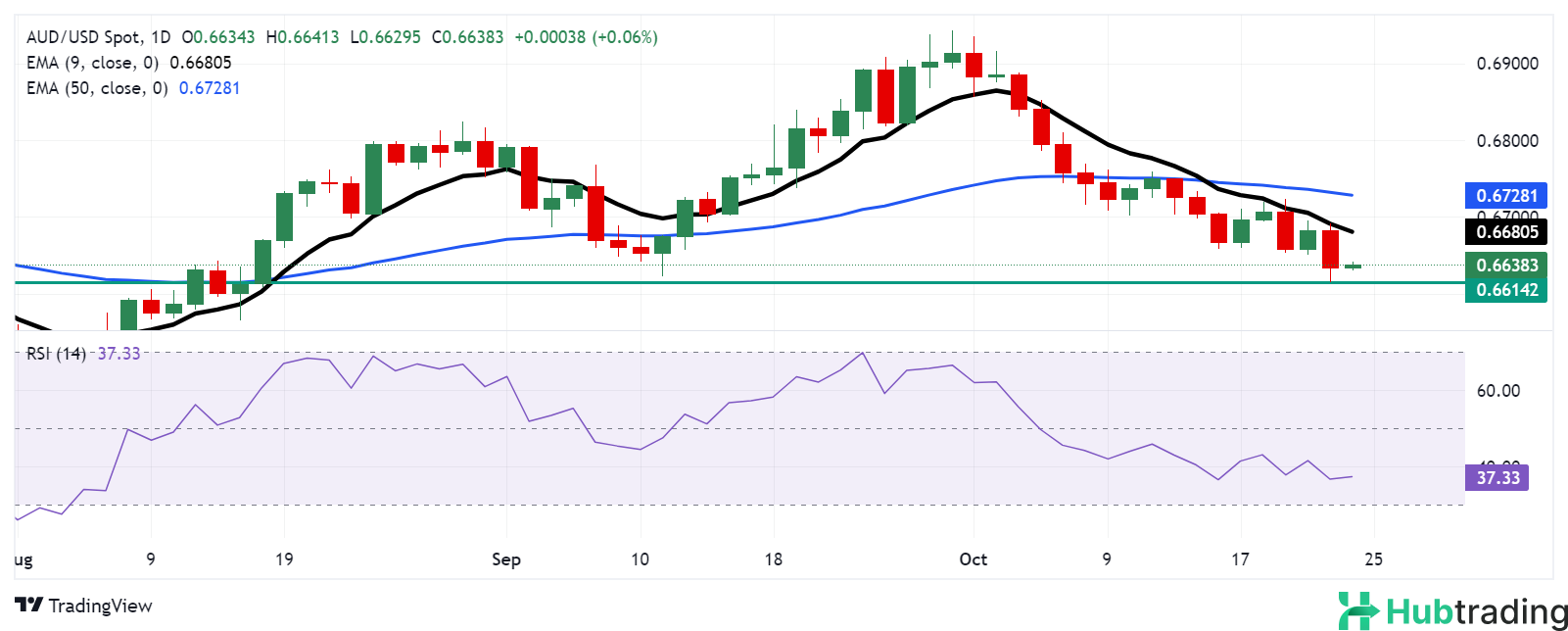-
The Australian Dollar remains strong following the release of Purchasing Managers Index data on Thursday.
-
Australia’s Judo Bank Services PMI rose to 50.6 in October, marking its ninth consecutive month of growth.
-
The Fed’s Beige Book report noted that economic activity was “little changed across nearly all Districts.”
The Australian Dollar (AUD) rose against the US Dollar (USD) on Thursday after the release of domestic Purchasing Managers Index (PMI) data. Additionally, the AUD/USD pair gained momentum as the USD weakened slightly due to a modest decline in US Treasury yields. At the time of writing, the 2-year and 10-year US Treasury yields stand at 4.07% and 4.23%, respectively.
The Australian Dollar could see additional support from the prevailing hawkish sentiment surrounding the Reserve Bank of Australia (RBA), reinforced by positive employment data. Earlier in the week, RBA Deputy Governor Andrew Hauser highlighted Australia’s high labor participation rate and emphasized that while the central bank is data-dependent, it is not “data-obsessed.”
The US Dollar faced downward pressure following the release of the Federal Reserve’s Beige Book on Wednesday, which reported that economic activity was “little changed in nearly all Districts,” compared to August’s report that showed growth in three Districts and flat activity in nine.
Traders will now focus on the upcoming S&P Global PMI, set to be released Thursday, which will provide further insight into the health of the US manufacturing and services sectors.
Daily Digest Market Movers: Australian Dollar Supported by Hawkish RBA Sentiment
- The CME FedWatch Tool shows an 88.9% probability of a 25-basis-point rate cut, with no expectation of a larger 50-basis-point reduction.
- Australia’s Judo Bank Composite PMI edged up to 49.8 in October from 49.6 in September, indicating a second consecutive month of contraction in private sector output. The Services PMI increased slightly to 50.6 from 50.5, marking its ninth consecutive month of expansion, while the Manufacturing PMI declined further to 46.6 from 46.7.
- Federal Reserve Bank of San Francisco President Mary Daly noted on social media that the US economy is in a better position, with inflation down and the labor market stabilizing.
- Federal Reserve Bank of Minneapolis President Neel Kashkari warned on Monday that the Fed is monitoring the US labor market closely for signs of destabilization, cautioning that any rate cuts are likely to be gradual and moderate.
- The People’s Bank of China (PBoC) lowered the 1-year Loan Prime Rate (LPR) to 3.10% from 3.35% and the 5-year LPR to 3.60% from 3.85%, in line with expectations. These cuts are expected to stimulate China’s economy, potentially boosting demand for Australian exports.
- National Australia Bank revised its forecast for RBA rate cuts, now expecting the first cut in February 2025, ahead of the previously projected May timeline, with rates expected to fall to 3.10% by early 2026.
Technical Analysis: Australian Dollar Remains Below 0.6650, Near Six-Week Lows
The AUD/USD pair is trading around 0.6640 on Thursday. Technical indicators suggest a short-term bearish outlook, as the pair remains below the nine-day Exponential Moving Average (EMA). The 14-day Relative Strength Index (RSI) is also below 50, reinforcing the bearish sentiment.
In terms of support, the AUD/USD pair may retest its two-month low of 0.6614, last reached on Wednesday, with further support at the psychological level of 0.6600. On the upside, resistance is seen at the nine-day EMA at 0.6680, followed by the 50-day EMA at 0.6728. A break above these levels could pave the way for a potential move toward the psychological resistance at 0.6800.
AUD/USD: Daily Chart






